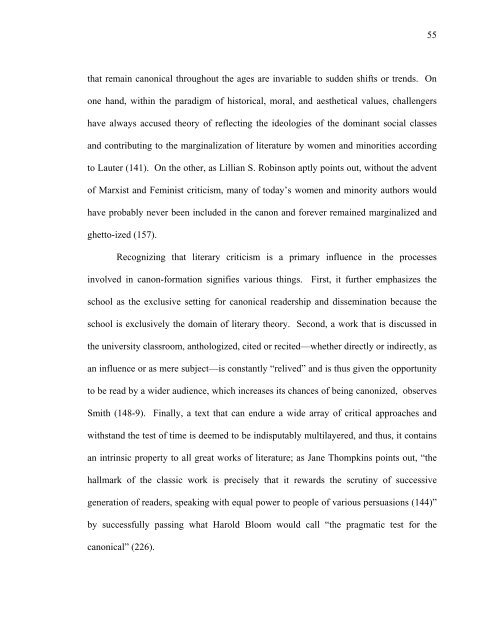Untitled - Sexey's School Moodle
Untitled - Sexey's School Moodle
Untitled - Sexey's School Moodle
Create successful ePaper yourself
Turn your PDF publications into a flip-book with our unique Google optimized e-Paper software.
that remain canonical throughout the ages are invariable to sudden shifts or trends. On<br />
one hand, within the paradigm of historical, moral, and aesthetical values, challengers<br />
have always accused theory of reflecting the ideologies of the dominant social classes<br />
and contributing to the marginalization of literature by women and minorities according<br />
to Lauter (141). On the other, as Lillian S. Robinson aptly points out, without the advent<br />
of Marxist and Feminist criticism, many of today’s women and minority authors would<br />
have probably never been included in the canon and forever remained marginalized and<br />
ghetto-ized (157).<br />
Recognizing that literary criticism is a primary influence in the processes<br />
involved in canon-formation signifies various things. First, it further emphasizes the<br />
school as the exclusive setting for canonical readership and dissemination because the<br />
school is exclusively the domain of literary theory. Second, a work that is discussed in<br />
the university classroom, anthologized, cited or recited—whether directly or indirectly, as<br />
an influence or as mere subject—is constantly “relived” and is thus given the opportunity<br />
to be read by a wider audience, which increases its chances of being canonized, observes<br />
Smith (148-9). Finally, a text that can endure a wide array of critical approaches and<br />
withstand the test of time is deemed to be indisputably multilayered, and thus, it contains<br />
an intrinsic property to all great works of literature; as Jane Thompkins points out, “the<br />
hallmark of the classic work is precisely that it rewards the scrutiny of successive<br />
generation of readers, speaking with equal power to people of various persuasions (144)”<br />
by successfully passing what Harold Bloom would call “the pragmatic test for the<br />
canonical” (226).<br />
55



